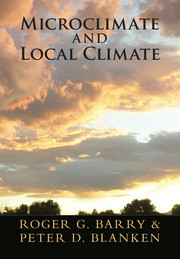Book contents
- Frontmatter
- Contents
- Preface
- Acknowledgments
- 1 Introduction
- Part I Controls of Microclimate
- 2 Microclimatic Elements
- 3 Methods of Observation and Instrumentation
- 4 Radiation
- 5 The Energy Balance
- 6 Monitoring Radiation, Energy, and Moisture Balance via Remote Sensing and Modeling with Land Surface Models
- 7 Microclimates of Different Vegetated Environments
- 8 Microclimates of Physical Systems
- 9 Bioclimatology
- Part II Local (Topo-)Climates
- Part III Environmental Change
- Problems
- Glossary
- Symbols
- System International (SI) Units and Conversions
- Index
- References
7 - Microclimates of Different Vegetated Environments
from Part I - Controls of Microclimate
Published online by Cambridge University Press: 05 May 2016
- Frontmatter
- Contents
- Preface
- Acknowledgments
- 1 Introduction
- Part I Controls of Microclimate
- 2 Microclimatic Elements
- 3 Methods of Observation and Instrumentation
- 4 Radiation
- 5 The Energy Balance
- 6 Monitoring Radiation, Energy, and Moisture Balance via Remote Sensing and Modeling with Land Surface Models
- 7 Microclimates of Different Vegetated Environments
- 8 Microclimates of Physical Systems
- 9 Bioclimatology
- Part II Local (Topo-)Climates
- Part III Environmental Change
- Problems
- Glossary
- Symbols
- System International (SI) Units and Conversions
- Index
- References
Summary
In this chapter we consider the primary characteristics of microclimates in different environmental settings. We examine in turn the landscapes of arctic and alpine tundra, grassland, farmland, wetlands, and forests. Small-scale atmospheric and edaphic processes that operate in the surface boundary layer are determined by these local environments, giving rise to contrasts in the radiation balance, temperature, humidity, and wind among the different surfaces and with height above and below the ground surface. It is these microclimates that provide the environmental controls for plants, insects, and other animals inhabiting that region (Monteith, 1976; Jones, 1992). Where appropriate data are available, we will include ecological information.
Tundra
Tundra is a term that originated in northern Finland, where it referred to treeless plateaus. Subsequently it has been extended to designate the land between the northern boundary of the boreal forest and high Arctic ice caps. It is also found on sub-Antarctic islands and in high alpine environments (Wielgolaski, 1997).
Tundra accounts for about 8 percent of the Earth's land surface. Microclimates are responsible for much of the diversity of the tundra environment. Low Sun angles mean that there is a great variety of local exposure to solar radiation. At the regional scale, the presence of a snow cover for nine months of the year has a major impact on the absorbed solar radiation.
Arctic Tundra
Lewis and Callaghan (1976) note that tundra embraces many different vegetation types ranging from dense willow scrub, through scrub heath and wet meadow, to sparse lichen and moss cushions. They selected wet meadow and dry fell field as extremes that were extensively studied during the International Biological Programme (IBP), 1964–1974. Peak LAI reaches unity in the meadow with a maximum canopy height of 20 cm. The full canopy develops within a few weeks of snowmelt. As little as 11 percent of solar insolation and 2–6 percent of PAR penetrate the full canopy. Dead leaves form an increasing portion of the canopy after midseason.
At fell field sites the LAI of higher plants is only about 0.1 m2 m−2. The canopy is discontinuous with large areas of bare ground. Wind is a major factor in fell field sites where the winter snow cover is discontinuous.
- Type
- Chapter
- Information
- Microclimate and Local Climate , pp. 148 - 186Publisher: Cambridge University PressPrint publication year: 2016



